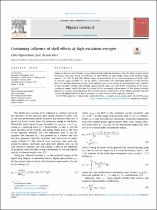| dc.contributor.author | Ngwetsheni, Cebo | |
| dc.contributor.author | Orce, José Nicolás | |
| dc.date.accessioned | 2023-03-02T11:15:38Z | |
| dc.date.available | 2023-03-02T11:15:38Z | |
| dc.date.issued | 2019 | |
| dc.identifier.citation | Ngwetsheni, C., & Orce, J. N. (2019). Continuing influence of shell effects at high-excitation energies. Physics Letters B, 792 , 335-339. https://doi.org/10.1016/j.physletb.2019.03.021 | en_US |
| dc.identifier.issn | 1873-2445 | |
| dc.identifier.uri | https://doi.org/10.1016/j.physletb.2019.03.021 | |
| dc.identifier.uri | http://hdl.handle.net/10566/8495 | |
| dc.description.abstract | Empirical drops in ground-state nuclear polarizabilities indicate deviations from the effect of giant dipole
resonances and may reveal the presence of shell effects in semi-magic nuclei with neutron magic
numbers N = 50, 82 and 126. Similar drops of polarizability in the quasi-continuum of nuclei with,
or close to, magic numbers N = 28, 50 and 82, could reflect the continuing influence of shell closures
up to the nucleon separation energy. These findings open a new avenue to investigating magic numbers
at high-excitation energies and strongly support recent large-scale shell-model calculations in the quasi-
continuum region, which describe the origin of the low-energy enhancement of the photon strength
function as induced paramagnetism. The nuclear-structure dependence of the photon-strength function
asserts the generalized Brink-Axel hypothesis as more universal than originally expected. | en_US |
| dc.language.iso | en | en_US |
| dc.publisher | Elsevier | en_US |
| dc.subject | Energy | en_US |
| dc.subject | Astronomy | en_US |
| dc.subject | Physics | en_US |
| dc.subject | Cosmology | en_US |
| dc.subject | Nuclear | en_US |
| dc.title | Continuing influence of shell effects at high-excitation energies | en_US |
| dc.type | Article | en_US |

